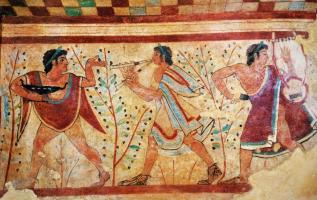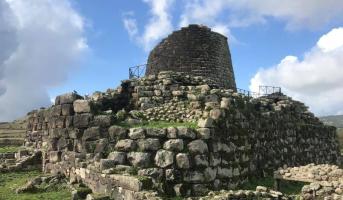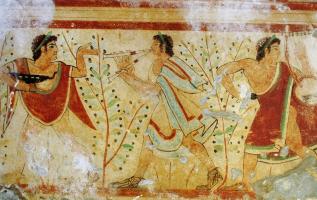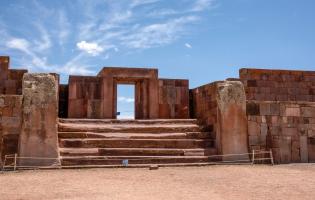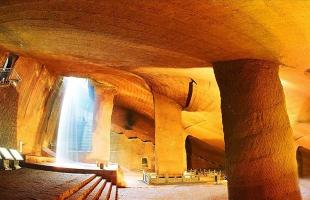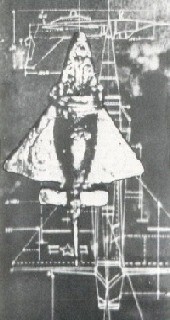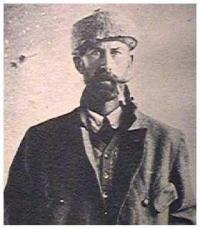The mysteries of the Etruscans

The Etruscans, called Tusci or Etruscans by the Romans and Tyrrhenian or Tyrseni by the Greeks, are still surrounded by an aura of mystery centered on two main problems: their origin and their language.
For Herodius (5th century B.C.) the origin of the Etruscans was more than peaceful: according to him the Etruscans came from Lydia, in Asia Minor, from where, under the reign of Ati, son of Mani, many left to save themselves from a terrible famine and, led by Ati's own son Tyrrhenian, landed in the land of the Umbrians, changing their name from Lidi to Tyrrhenian. "In their poems," wrote Raymond Bloch in 'The Etruscans,' Virgil, Ovid and Horace often called the Etruscans, Lidi. According to Tacitus, under the Roman Empire ... the Lidi still considered themselves brothers of the Etruscans. Seneca takes, as an example of the migration of an entire people, that of the Etruscans, and writes: 'Tuscos Asia sibi vindicat,' that translates into "Asia claims to to gave the paternity to the Etruscans."
Another Greek, historian and philosopher, Dionysius of Halicarnassus, who lived in Rome under Augustus (in the years 30-8 B.C.) contradicted the hypothesis of the Tyrrhenians migrating from Lydia. Noting the diversity of language and religion between the Tyrrhenians and Lydians, Dionysius thus ruled, "It seems to me that those who assert that the Etruscans are not an immigrant people from foreign lands, but an indigenous race, are right; and this seems to me to derive from the fact that they are a very ancient people who resemble no other both in language and traditions."
The question after two thousand years is far from be resolved, and among the diatribes of contemporary historians a third hypothesis is gaining ground: "The Etruscan civilization, as we know it," wrote Annette Rathje in 1987, "developed without doubt on Italian territory, as the fusion of an ancient Italic tradition with higher cultures (East and Greece). The question 'where did the Etruscans come from' becomes a false question."
The Etruscan language became, or rather re-became, readable in recent times (but survived until the fifth century) after strenuous efforts by glottologists on the 10,000 or so inscriptions found in Tuscany in addition to the fairly lengthy ones on the "Capua tile", the "cippus of Perugia," and the linen bandages of a Greco-Roman mummy found in Alexandria and now preserved in the Zagreb Museum. The latter find, in particular, contains about 1,500 words, but since these are ritual formulas related to a sacred calendar enumerating religious ceremonies, only 500 words differs. In essence, Etruscan is roughly incomprehensible in the meaning of the phrases, even though the meaning of a fair number of words is now known and despite the fact that scholars and amateurs continually churn out hypotheses and interpretive "keys" that have punctually turned out to be unsuitable. Archaeologists and linguists complain about the lack, for the Etruscan language, of the equivalent of the "Rosetta stone" that enabled Champollion to interpret Egyptian hieroglyphics. While waiting, then, for a bilingual or trilingual inscription long enough to satisfy all the morphological and syntactic doubts of Etruscan, one can only set aside the problem, which is perhaps also false, since language is only one of the means of expression of a people.
Farmers as well as agrimensors and then urban planners, metallurgists and then fearsome warriors with their bronze and then iron weapons, artists but also merchants, navigators, pirates and colonizers, the Etruscans spoke both through the historical events they witnessed throughout the Mediterranean basin from the ninth to the first centuries B.C., through the admirable testimonies of their art, and through the cultural, religious and moral inheritance they beamed almost entirely into the civilization of Rome, helping to structure it from its origins.
In looking, however, at the historical deeds of the Etruscans, their artistic and urbanistic testimonies and their "legacies" to the Romans, there is a danger of running into other false problems and not "seeing" all together the profound reality of this people, which has so many affinities with the cultures of Asia Minor, Babylon, and Greece, but also with the Maltese (if only with that of Tarxien of decadence and the hypogeum of Hal Saflieni), Phoenician and Punic cultures. Yet it retains an originality of its own by relying on a revealed religion that informs public, family and individual life with itself, as totally as distressingly.
To understand the Etruscans, as with other civilizations, it is necessary to ask what was their cosmogony, their theogony, and thus what were their analogical, practical, ritual and profane, public and private applications (if ever a privateness could exist in a highly committed realm of the all-encompassingness of a fatal bond between humans and gods).
According to Raymond Bloch, the Etruscans show singular aspects that are clearly differentiated from the Greeks and Romans. Their attitude toward divinity and fate "is more restless," he wrote, "if not even anxious, and their approach to life seems marked by the search for omens that foreshadow a future over which it is almost impossible to exercise any influence. Everything in the life of the individual, the city and the Etruscan people seems, for Bloch as for other historians, to "obey a kind of predetermination, which cannot produce anything but a form of widespread pessimism." In this sentence, however, two abstractions should be noted, two rhetorical and structural figures typical of modern Western thought, but incomprehensible, perhaps even inconceivable, three millennia ago.
Predetermination, for the thought of peoples coeval with the Etruscan, could be intuited, glimpsed as the rhythm and order never fully intelligible of a world strongly unified in all its manifold manifestations from the divine, to the human, to the natural. The concept then of widespread pessimism (or optimism), could only be an effect, a signal not certainly a behavioral cause, indicating the collective soul's responsiveness and agreement to that rhythm, that order.
"Unlike the Greeks and Latins, but analogous to several Eastern peoples, the Etruscans," Bloch again writes, "conceive of nature as subordinate to a universal end: the phenomena that offer themselves are conceived as produced by the divine will to make man aware of his duties and his future destiny. Everything is reduced, therefore, to mantics, which appears precisely to be the universal science."
Even in this case some pitfalls may be hidden. The Etruscan soothsayer, in fact, whether he was àugure (specializing in interpreting the flight of birds), haruspice (reader of the entrails and liver of sacrificed animals), expert in brontoscopy (thunder) worshipper of librifulgurales (on lightning) or simple astrologer was not limited to the observation and divination of ostenta (wonders), but provided atonement, restoration of violated order, facilitation of the supposed will of the gods or deflection, delay of the predicted coming misfortune. More, like shamans, Etruscan soothsayers encroached on magic in that it has been handed down that they knew how to cause certain prodigies and were priests, in the etymological sense of the term, in that they were custodians of rituales.
Masters, evidently in the most archaic age, of knowledge that embraced life and death, the sciences and the arts, religiosity and the guidance of public affairs, the Etruscan priests knew how to make the society of the beginning Iron Age blossom, between 900 and 720 B.C. of the crude Villanovan culture, a stupendous civilization that transformed small villages hinged on autonomous families, into mighty and rich city-states foreshadowing the imperial dream of Rome.
As a myth of their own origins, or rather of the origins of their flourishing, the Etruscans have handed down to us the legend of Marigolds, son of Genius and grandson of Jupiter, small as a child, with silvery hair and the wisdom of an old man, sprung from a clod of earth touched by a farmer's plow teaching the whole of Etruria all the discipline that embraced the most advanced human and divinely inspired knowledge. Another figure, muliebre, a prophetess, nymph or sibyl, named Vegola or Begoe, complements the teaching of Marigolds with ars fuguratoria and agrimensura, which are of basic importance to the Etruscans first and to the Romans later.
These myths cannot only pertain to the domain (far too fenced in with high fences) of the history of religions but can at least be used as tools for understanding the history and culture of a people, whether sacred or profane. Indeed, the scheme of the "liver of Piacenza" (bronze sketch of a sheep's liver found in that city in 1877) with its 40 boxes each containing the name of a god, its spatial delimitations and its 16 border boxes that are clearly astronomically and astrologically derived is not without practical significance for the glottologist. This same pattern is analogous to that of related Babylonian artifacts and is still present in the city plan of Rome today. Nor should the long litany of formulas written on the Zagreb mummy's bandages be without practical significance, only that one would try to interpenetrate the worldview typical of the Etruscans.
This vision involved a mysterious council of gods superiores et involuti, to which the triad of main deities was subjected: Tinia (Jupiter), Uni (Juno) and Metirva (Minerva). Temples dedicated to this triad were to be located in the cities in excellentissimo loco at the three main cardinal points (East, South and West, the North being blind as the inaccessible seat of the gods) or in a single point (as in the Greek Acropolis) and in a single three-cell temple (as in that of Jupiter on the Capitol, in Rome, or as that of Apollo, in Veio).
Below the main triad, there are other triads of deities more or less similar to those of the Greco-Roman Olympus: Aplu (Apollo), Artumes (Artemis), Turms (Mercury), Nethuns (Neptune), Maris (Mars), Turan (Venus), etc., grouped at 12, like the signs of the Zodiac, at 7, like the Planets, at 16 like the areas of the sky.
From these religious conceptions as well as from the application in the urban fabric of the sacred rules of agrimensura arose the prescription of the Etruscan Libri rituales on the checkerboard arrangement of the plan of cities with a well-defined orientation established by the àuguri.
Of the Etruscan temples, with their wooden load-bearing structures, sun-baked clay walls, roof tiles and terracotta pediment and ridge ornaments, not much remains given the perishability of the materials used.
Of the sanctuary of Volthumna, in an unspecified location in the area of Lake Bolsena, where the whole of Etruria gathered every year, barely a memory of the name remains. (That this shrine, too, as was the case in front of the temple of Tarxien in Malta, was erected with trunks of trees considered faustful?)
And there remained instead, conspicuous, the evidence of what was designed for motionless eternity, sometimes serene and sometimes (often in the period of decadence) somber. The otherworldly fate was one of the main concerns of the Etruscans, and it is thanks to this anguish, diluted or kindled according to the various eras, that we know almost everything about them. "The Etruscans," Annette Rathie wrote again, "held their dead in high regard. Like the Egyptians, they believed that the dead continued to live in the grave. Therefore, they buried the dead along with their personal belongings and did much to protect them," whether-it is the case to add through appropriate rituals or through statues of "guardians."
In the early period, in a typically Eastern custom, they burned the remains and put their ashes in urns called canopic jars.
Beginning in the 8th century B.C. the dead are buried in pits dug in the tuff. From the 7th century entire burial chambers are built covered with earth "in tumulus." Entire necropolises were then born, located on high ground, near cities and along main roads, and in them the most important treasures of Etruscan art were found, often plundered: sarcophagi, weapons, jewelry, furnishings, pottery, statues, reliefs, inscriptions and frescoes. The latter, above all, depict in the Archaic period a worldview, albeit an otherworldly one, serene and affluent, obviously for the ruling classes.
After 474 B.C.E., however, when the secula that Fate had granted to the Etruscans were about to come to fruition, and after appropriate prodigies and divine warnings had manifested themselves (in practice after the heavy defeat at Cumae that ousted the Tyrrhenians from dominance over the seas) the atmosphere of the tombs becomes somber and gradually terrifying. Alta (Hades) and Phersipnai (Persephone) transform into frightening beings who, together with a livid and sneering Charon, accompany the souls on a journey, in which other repulsive and menacing figures do not bode well. As if even the souls of individuals are but shreds of a collective soul that has come to the end of its cycle ... before another cycle flourishes and bears fruit in another form.









